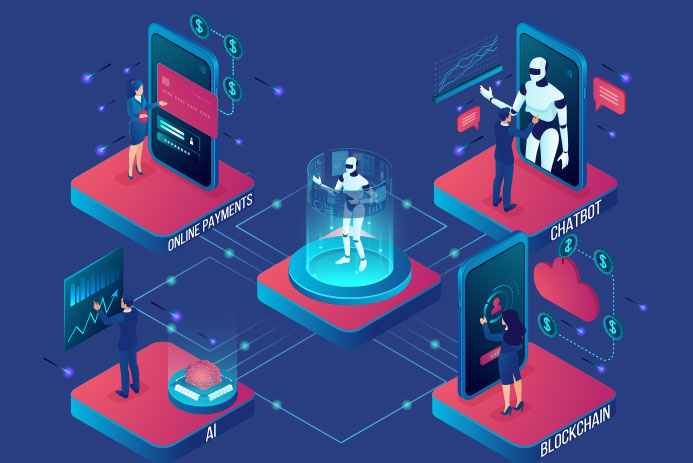The banking industry has always been at the forefront of adopting emerging technologies and has a strong track record for technology-led leadership. This is true in the case of AI too, which has been adopted by many banks in a variety of important functions. Today, this assumes greater significance, as the usage of online and mobile banking channels has risen significantly, and customers have cut down their branch visits in the wake of the pandemic. This has pushed banks to raise their bar for providing digital experiences, as customers expect the same experience that they have been accustomed to from digital upstarts.
With AI, banks can achieve their objectives, as this technology can truly be used to automate their processes (leading to greater efficiencies), engaging with customers and personalising experiences (leading to better customer satisfaction) and risk management. Let us now look at some critical areas in a bank where AI can make a pivotal difference.
Speeding up the process of customer onboarding
AI can make a significant difference in the way banks onboard customers. For example, when a customer wants to open a new bank account or applies for a loan, he or she has to provide a number of documents and identification proofs to the bank. The bank then has to physically scan each document to authenticate the document. This is even more applicable when a customer applies for a loan, and a bank checks bank statements, identification proofs, and other financial details to determine the credit worthiness of the customer. As these are manual activities, they are error-prone and time consuming. Additionally, as there is no real-time verification of information submitted by the customer, there is a possibility of missing or inadequate information.
In an AI-enabled eKYC platform, the entire process can be automated by using AI-driven face match and document verification algorithms. Once the process of eKYC starts, the data from the Government issued ID card and photo can be matched with the live selfie video to authenticate the customer. Data from ID cards is extracted using smart OCR and validated against government supported databases. This helps in completing the KYC in less than one minute compared to a minimum of 2-3 days that is required for customer onboarding.
AI can play a big role in reconciliation too. Today, a significant percentage of reconciliation efforts is spent on analysing transactions that already match, instead of focusing on the entries that require more analysis and investigation. AI can help in completely automating the reconciliation process and reduce the time and efforts that it takes to reconcile transactions. As the process is completely automated, there is no possibility of errors.
Raising the bar for customer experience
AI’s potential in raising the bar for customer experience is the highest in the banking industry. The most basic usage of the power of AI can be seen from the way banks have used chatbots to answer customer queries, besides customer acquisition and engagement. A study by Juniper Research in 2019 estimated that the operational cost savings from using chatbots in banking will reach $7.3 billion globally by 2023. While chatbots are now used by almost every bank, a bigger potential for AI lies in personalising experiences for customers. Considering the huge amount of data that banks have at their disposal (demographic data, transaction data, credit card spends, e-commerce transactions), banks are extremely well placed to hyper-personalise the experience for a customer.
The Boston Consulting Group estimates that a bank can garner as much as $300 million in revenue growth for every $100 billion that it has in assets, by personalising its customer interactions. For example, if a customer is paying rent of Rs 20,000 every month, then the AI model could recommend a home loan to you and show you how the EMI for the house could be a lot lesser than the rent you are paying every month. Similar recommendations can be made by the AI engine when a person crosses a certain age-threshold and suggestions can accordingly be made (health insurance, education loan, etc). AI can also understand and suggest the preferred channel that a specific customer prefers to interact with the bank – some are comfortable with email, some with telephonic calls or some could prefer to interact via chat only.
Preventing fraud
Despite huge technological advances, frauds are a common occurrence, and have only grown in scale. AI’s ability to learn and analyse each banking transaction can be used to prevent frauds. For example, if your credit card has never ever been used abroad, and if a transaction takes place on your card, then the AI system can flag this off, and automatically place a call to you to verify the transaction. If an account is being logged in at an hour that has never ever been recorded in the transaction history of an individual, then the AI system can flag this transaction to the bank.
Banks are also leveraging AI and ML for monitoring purposes. For instance, AI/ML engines are being used analyse data and then breaking them down to detect any malicious activity or presence of any compromising malware. Apart from security prioritization, AI also helps in assessing phishing websites, malicious attempts, and all other vulnerabilities.
Similarly, AI can be a big powerful asset in leading the fight against anti-money laundering. An AI powered anti-money laundering solution can monitor for example, small innocuous irregular deposits that are then transferred to a global merchant. By shifting through mountains of data and connected entities, the AI system can identify patterns that signify money laundering and provide a bank with insights into previously unknown relationships.
How can AI enable Banking-as-a-Service?
For AI to run efficiently, it needs huge amount of computational power. While HPC systems are well equipped to power AI-driven transactions, the cost is prohibitive. This is where HPC as a service can be utilized for accessing AI as a service.
This gives cost efficiencies with guaranteed performance. This requires zero CAPEX investment and can be consumed using a pay-as-you-use model. Scalability is also not an issue and can be scaled up or down as per the workloads.
Democratisation of AI is not possible today as AI is not accessible by all and is considered too costly to implement. This can be made possible by adopting Banking-as-a-Service, which is enabled by AI. All banking related services can be consumed as a service. Small banks or financial institutions that do not have access to AI powered solutions can use Banking-as-a-Service, as all these solutions are available on a pay-per-use model. Currently, the usage of AI in banking is low, primarily because of infrastructure-related costs. This is where High Performance Computing-as-a-Service can be a big catalyst for democratising the usage of AI.
Today, a bank’s competition may not strictly be a bank, and can be a pure play technology company. Technology companies who have a deeper understanding of technology and work on huge data sets are better placed to provide a better customer experience. Samsung, Google and Apple are some of the best examples that showcase this capability. The popularity of Google Pay shows how relatively new entrants with deep technology expertise can disrupt the payments space. Banks have also understood the significance of these disruptive technologies and are actively partnering or investing in startups who specialise in emerging technologies. A case in point is ICICI Bank, which has taken a stake in Tapits Technologies, a startup that enables contactless merchant onboarding using eKYC.
In the future, as more banks embrace a more digital future, it will be imperative for all banks to have an AI-first approach. Even the government has time and again emphasised that for banks to transform and fulfill India’s growing needs, they mist harness technologies like AI and Big Data. As more digital only banks enter the fray, this approach will be critical in defining their future competitiveness!

















 Back
Back








